Authentic Niter Kibbeh (Ethiopian Spiced Clarified Butter)
This post may contain affiliate links. See my disclosure policy.
If you love Ethiopian food and just can’t quite figure out how to replicate that flavor at home, you may be missing the ultimate secret ingredient: Niter Kibbeh!
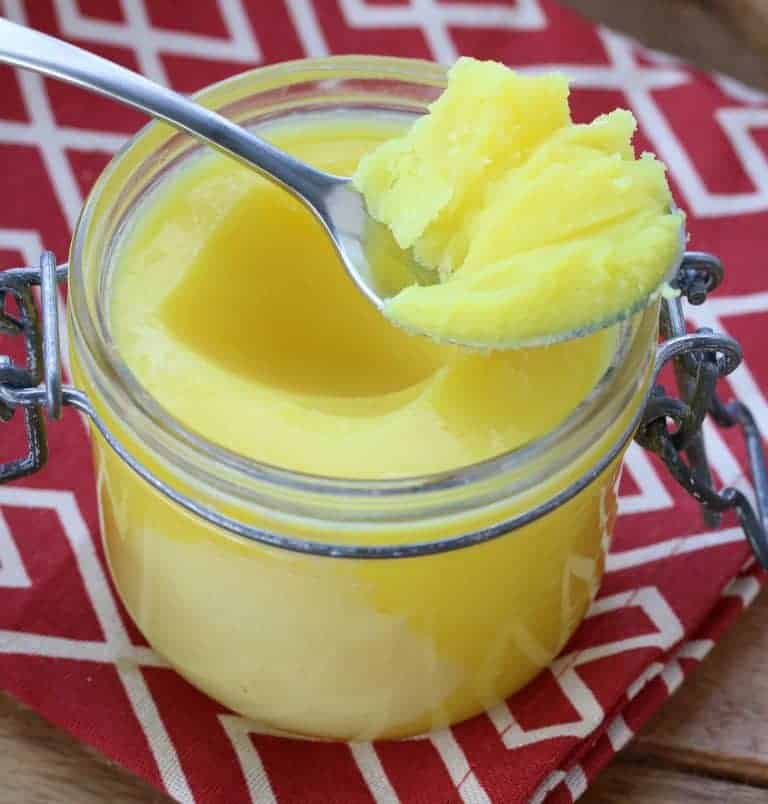
What is Niter Kibbeh?
Niter Kibbeh (Nit’ir Qibe) is an ingredient integral to Ethiopian cuisine and is made by clarifying butter that has been infused with herbs and spices. In the process of clarifying the spiced butter, the same process used to make ghee, the butterfat is separated from the milk solids and water and the result is a highly aromatic and flavorful cooking fat. This clarified butter has a higher smoke point and longer shelf life than regular butter.
How To Use Niter Kibbeh
While niter kibbeh is famously used in Ethiopia’s national dish, Doro Wat, it is highly versatile and used to bring life and flavor to a wide variety of dishes, including Sega Wat, Misir Wat and Gomen. Include a dollop in your favorite stews, your beans and lentils, sauces and gravies, add some to your vegetables and eggs, use it to brown your meat or chicken, spread some on your sandwich…and then sit back and savor your meal.
Ingredients
For a truly authentic niter kibbeh you would include two Ethiopian spices that are very difficult to find outside of Ethiopia: Besobela and Kosseret. Besobela is also known as Ethiopian sacred basil though it tastes nothing like basil. It’s also traditionally included in Berbere, the famous fiery hot Ethiopian spice blend. Kosseret is in the verbena family of plants and likewise has a very unique flavor. There are no adequate substitutes for either. If you can find them, use about a tablespoon of each. If you can’t, simply omit them. The resulting niter kibbeh will still be incredibly delicious without them.
Another central ingredient to niter kibbeh is cardamom. But it’s not the green cardamom that most of us are familiar with. Rather it’s a type of cardamom that’s much bigger in size and is brown in color, known as korarima, false cardamom and Ethiopian cardamom. And it’s tastes completely different than green cardamom.
The bad news is that it’s nearly impossible to find. The good news is that you can substitute Indian black cardamom (pictured below in comparison to the more commonly known green cardamom). It more closely resembles Ethiopian cardamom in flavor than does green cardamom and is an absolutely vital spice in Ethiopian cooking.
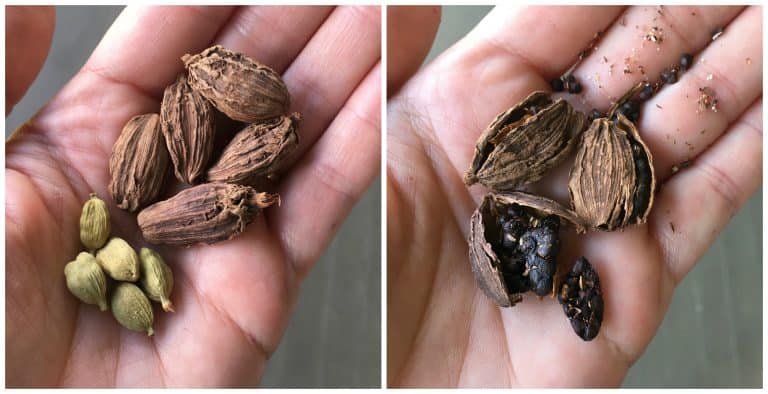
Niter kibbeh is a wonderful and uniquely delicious clarified butter that you will fall in love with. And absolutely nothing compares to homemade niter kibbeh. Once you’ve made it (it’s super easy) and tried it (it’s incredible) you’ll make it again and again!
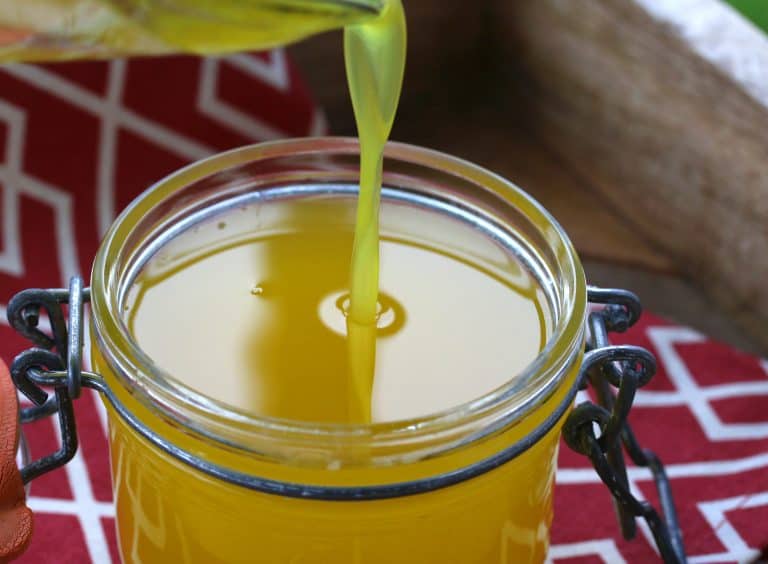
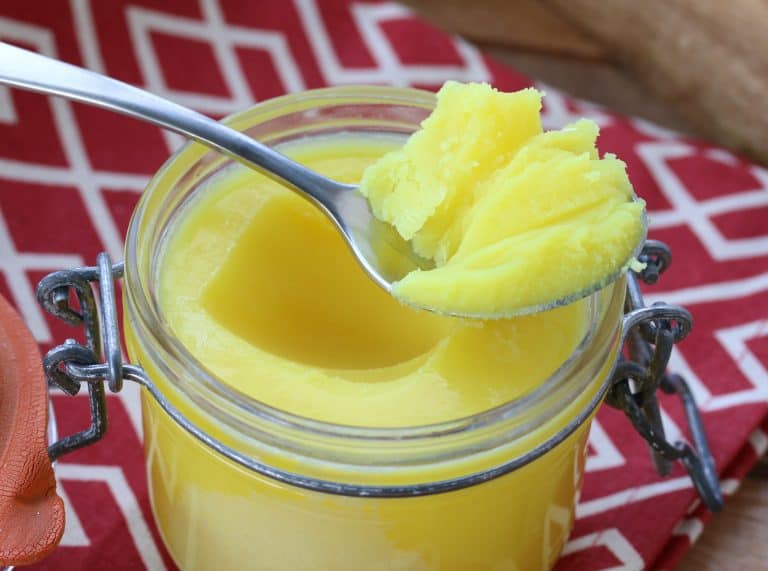
Authentic Niter Kibbeh Recipe
Let’s get started!
Toast the whole spices over medium heat in a dry skillet for a few minutes until very fragrant. Be careful not to scorch the spices or they will become bitter.
Place all the ingredients in a medium saucepan and bring it to an extremely low simmer. Continue to simmer over low for at least one hour or up to 90 minutes. BE VERY CAREFUL NOT TO BURN THE BUTTER. If it burns it will be bitter and there is no salvaging it.
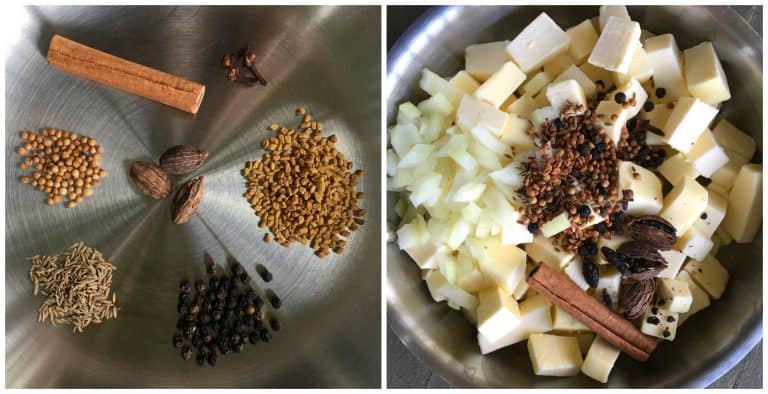
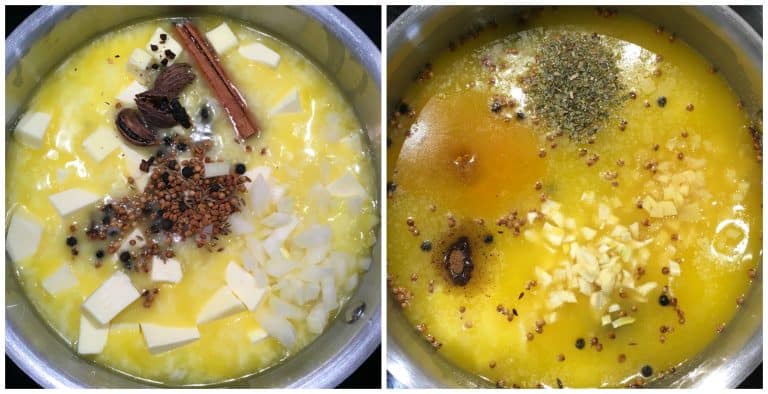
Pour everything through a fine-mesh cheesecloth. (No need to skim off the foam, everything will be removed during straining.)
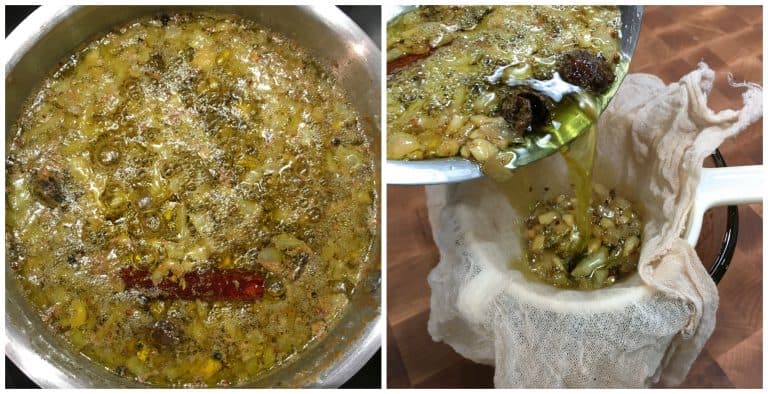
Pour the niter kibbeh into a jar, let it cool, cover so it is airtight. It will keep at room temperature for a few weeks, in the fridge for a few months, and even longer in the freezer (it will be hard in the fridge and freezer, let it come to room temp for easy scooping). Makes about 2 cups.
Enjoy!
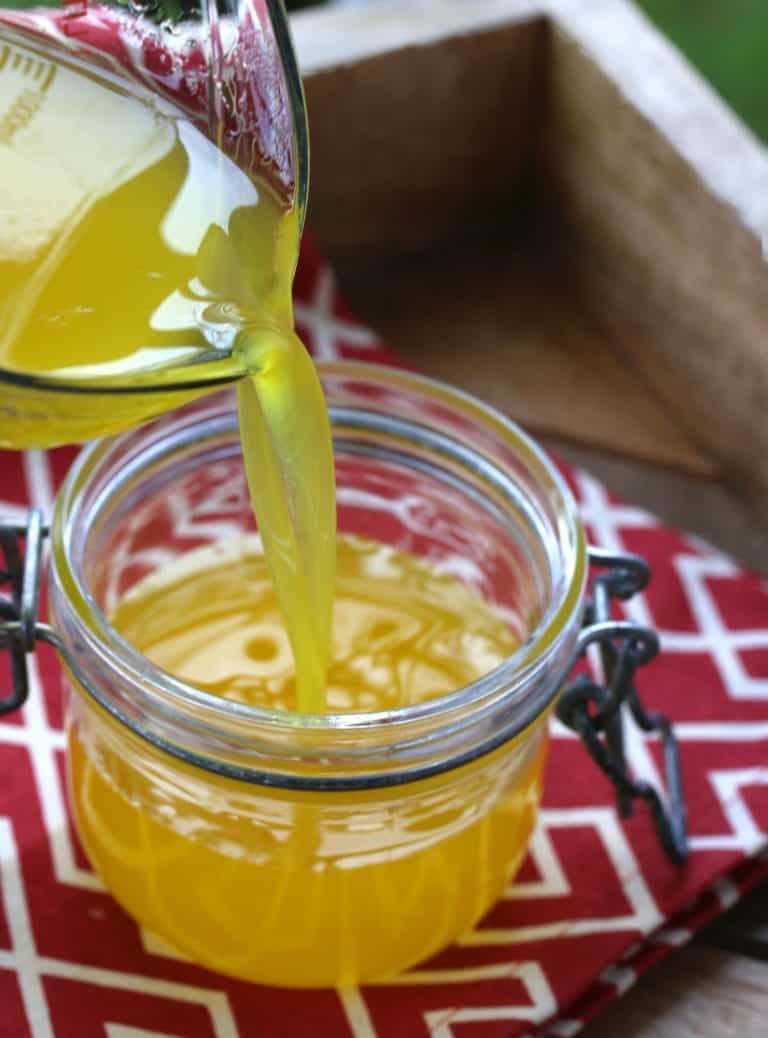
For more delicious and authentic Ethiopian recipes, be sure to try my:
Save This Recipe
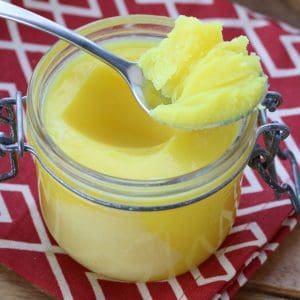
Authentic Niter Kibbeh (Ethiopian Spiced Clarified Butter)
Ingredients
- 1 pound unsalted butter, cubed
- 1/4 cup chopped yellow onion
- 3 tablespoons minced fresh garlic
- 2 tablespoons minced fresh ginger
- 1 2-inch cinnamon stick
- 1 teaspoon whole black peppercorns
- 3 BLACK cardamom pods (not the green cardamom variety)
- 3 whole cloves
- 1 teaspoon fenugreek seeds
- 1 teaspoons coriander seeds
- 1 teaspoon dried oregano
- 1/2 teaspoon cumin seeds
- 1/4 teaspoon ground nutmeg
- 1/4 teaspoon ground turmeric
- 1 tablespoon besobela ,if you can find it, otherwise omit (see blog post)
- 1 tablespoon kosseret ,if you can find it, otherwise omit (see blog post)
Instructions
- Toast the whole spices over medium heat in a dry skillet for a few minutes until very fragrant. Be careful not to scorch the spices or they will become bitter. Set aside.
- Place all the ingredients in a medium saucepan and bring it to an extremely low simmer. Continue to simmer over low for at least one hour or up to 90 minutes. BE VERY CAREFUL NOT TO BURN THE BUTTER. If it burns it will be bitter and there is no salvaging it.
- Pour everything through a fine-mesh cheesecloth. (No need to skim off the foam, everything will be removed during straining.) Pour the niter kibbeh into a jar, let it cool, and cover so that it is airtight. It will keep at room temperature for several weeks, in the fridge for a few months, and even longer in the freezer (it will be hard in the fridge and freezer, let it come to room temp for easy scooping). Makes about 2 cups.



















Good variation of kibbeh. Thanks for making this available to people. Just a heads up to anyone looking for the ingredients.
You cannot really omit Kosseret and still call it real kibbeh. Along with the besobela, the flavor would not be considered authentic. If you are privy to Ethiopian flavors, you would feel something is lacking when enjoying certain dishes that use kibbeh as a base.
After the spices are separated using the cheese cloth- is there something yummy I can do with the spices? Seems like a yummy thing to throw out…
Hi Carl, the spices in the cheesecloth can be kept in the fridge for a few days until you’re ready to use them and then whatever Ethiopian dish you’re making next (e.g., doro wat, misir wat, etc), you can hang the cheesecloth in the pot while the dish is simmering to add some extra flavor.
I tried this once as per the recipe and burned it – ruined it.
The second time I tried it I clarified the butter first, before adding all the ingredients. Worked much better, as without the milk fat there’s much less chance of it burning during prolonged cooking.
Hello,
Can I ask if it would still be OK with salted (demi-sel) butter rather than unsalted?
Many thanks in advance!
Hi Isabelle, yes you can use salted. Your niter kibbeh will just be salty, so when adding it to another dish just reduce any other added salt.
Left the garlic whole just to minimize chances of burning (scooped it up after 90mins and spread it on toast,so good!) Also used the niter kibbeh to cook my baby’s food and she loved it. I’m gonna triple the recipe next time because its already half gone before I had a chance to try all the other Ethiopian recipes I planned to make 😅 Amazing recipe! Thank you!
Wonderful, ML, thank you so much for the feedback, I’m thrilled you and Baby enjoyed it! :)
I made this with black cardamom, and it was delicious. I’ve been hunting for Korerima, and finally found it; the only issue it is in seed form. Can these be used, and how much versus the black cardamom pods? The seeds are also a lot larger than cardamom seeds.
Hi Che, I’m so glad you enjoyed it, thank you! Yes, you can use the seeds instead of the whole pod. I’d aim for about 3/4 teaspoon of the korerima seeds. Happy cooking!
Hi, we’d like to try this but a family member is allergic to dairy. What would be a good substitute for the butter please?
I cook it on the lowest heat but the onions and garlic are completely fried black after 20 min in the butter. How do you do this for 60-90 min without having burned onions and garlic in there?
Hi Marcellus, it must be cooked over extremely low heat. I don’t know what kind of stove you’re using but if your lowest heat setting resulted in completely black onions and garlic then there’s definitely something wrong with your stove.
Put something on top of the stove top to raise it. Or use a heavier bottomed pan like a enamel Dutch oven
I don’t understand how you can get a nice light yellow color after simmering all these spices. Especially black cardamom, cinnamon. You’re gonna end up with a deep brown colored liquid regardless so how are your pictures yellow?
Hi Karan, that’s the purpose for using whole spices. Whole black cardamom and whole cinnamon sticks won’t discolor the butter and you will indeed end up with a beautiful golden-colored spiced clarified butter like in the pictures.
You have to let the spices settle it will eventually seperate.
Giving thanks for the recipe intend to make it tomorrow and I like to know if it is possible to replace Beso Bela with ordinary basil (dried leaves)?
Hi Fernando, besobela tastes nothing like ordinary basil and the latter would not pair well with the niter kibbeh. I would simply omit it – the niter kibbeh will still taste absolutely amazing! :)
I make this in my small crockpot, set on low. I can’t burn it that way! After several hours, the aroma is unbearably delicious. I always share my niter kibbeh with friends who are unfamiliar with it. They all rave about how great their vegetables taste when sauteed with the kibbeh! Thank you for this great recipe!
Thank you so much, Liz, I’m happy it’s been a hit!
Korarima (Ethiopian Cardamom) looks more like Indian/Himalayan Black Cardamom, but its flavor is closer to (though stronger than) regular green cardamom. Indian black cardamom is much smokier with a very different flavor profile. If you want to duplicate the more traditional flavor of Niter Kibbeh, you are better off just substituting green cardamom for the Korarima. (That is not to say that the Indian Black Cardamom does not add its own unique spin to the flavor profile).
Very satisfied. I have been searching in stores and online shops for years and finally found this. Thanks so much for helping me enjoy such a wonderful, tasty, and authentic experience of food far away from home.
Thank you, Rachel, I’m so happy you enjoyed it!
Coming from someone whos household members often run outside when I begin to cook, this Niter Kibbeh may be the best smell I’ve ever created in my life. (I used the garlic I had on hand, which was fermented . . . we’ll see how that goes)
What a win, Jesse, congratulations and I hope you enjoy the end result!
I made some recently without the three specialty ingredients because I didn’t want to wait for spices in the mail. The smell while making it was intoxicating, and the flavor made me realize that I’ll be using this for more than just Ethiopian recipes. I’m ordering the additional spices now to make the complete recipe.
Looks like you crack the cardamom pods so that they are partially open before using?
Wonderful, David, I’m so glad you enjoyed it, thank you! Yes, I typically crack them because the seeds inside is where the flavor is.
So I was able to find korarima (Kalustyan’s in NYC carries it) but it’s just the seeds rather than the whole pods. How much should I use? A Teaspoon?
Fantastic, Paul! Yes, I’d aim for a teaspoon. Happy cooking and please let us know how it goes!